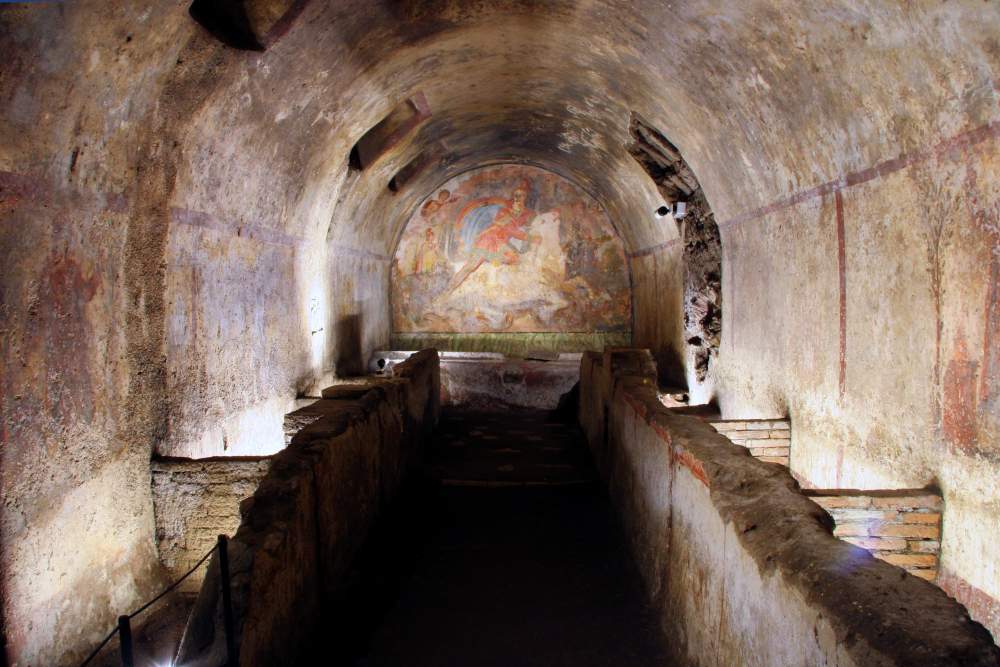Caserta, reopens the Mitreo of Santa Maria Capua Vetere.
The preparatory activities for the restoration of the Mithraeum of Santa Maria Capua Vetere (Caserta), aimed at carrying out appropriate restoration work on the monument, conducted by theCentral Institute for Restoration in Rome (ICR) and theUniversity of Molise, have been concluded. In particular, the Central Institute for Restoration in Rome conducted a campaign of analysis of the microclimate and of the pictorial surfaces, while the University of Molise carried out a geognostic campaign, not only of the hypogeum, but also of the compartments bordering and overlying the Mitreo, coordinated by Paolo Mauriello. As a result of the diagnostic campaign, a new, low-energy lighting system, which does not alter the microclimate or the pictorial surfaces, was installed, along with an information apparatus that, placed in the room preceding the entrance to the worship hall proper, illustrates to the public the Mithraeum and the investigations conducted on its paintings.
Dated to the late first century CE, the Mithraeum is considered the oldest in the West and one of the most important Mithraic sites. The solar cult of Indo-Persian origin arrived in Campania through slaves and merchants who arrived from the port of Delos in Puteoli (today Pozzuoli). In the West, the cult takes on mystery characters and spreads between the second and third centuries CE, especially among military personnel, slaves and gladiators. In Capua, home to one of the best-known gladiatorial schools, it spread early; indeed, the presence of Mithras among the deities of the arch keys of the Amphitheater is significant. Discovered in 1922 and open to visitors since 1937, the Mithraeum is accessible from a turret building from which one descends into underground chambers that evoke the cave in which Mithras was born and imprisoned the bull. Through a dark vestibule one enters the impressive worship hall, where the eye is captured by the megalography with the scene of the sacrifice of the bull.
In compliance with ICR guidelines, dictated for the purpose of preserving the paintings, it will be possible to enter the Mithraeum only by prior reservation, in groups of up to five visitors in turn, who will be accompanied by a receptionist and site supervisor. In order to respect the conservation requirements of the wall paintings, ten minutes will be allowed in the introductory room for the visit, located outside the original rooms of the Mithraeum, to allow for the reading of the descriptive panels; an additional ten minutes will be provided for the visit in the worship hall.
Visits are scheduled at 10 a.m., 11 a.m., 2:30 p.m., and 3 p.m., for a maximum of twenty visitors per day, on Sunday, October 15, Tuesday, October 17, Saturday, October 21, Wednesday, October 25, Sunday, October 29, Tuesday, October 31, Tuesday, November 7, Saturday, November 11, Wednesday, November 15, Sunday, November 19, Tuesday, November 21, Saturday, November 25, and Tuesday, November 28. The schedule of subsequent visitation dates will be announced at a later date.
Mandatory reservations should be made at the ticket office number (+39 0823 1831093), no later than 3:30 p.m. the day before the visit. Reservations for the Tuesday visit will be required no later than 3:30 p.m. on the previous Sunday.
 |
| Caserta, reopens the Mitreo of Santa Maria Capua Vetere. |
Warning: the translation into English of the original Italian article was created using automatic tools. We undertake to review all articles, but we do not guarantee the total absence of inaccuracies in the translation due to the program. You can find the original by clicking on the ITA button. If you find any mistake,please contact us.





























